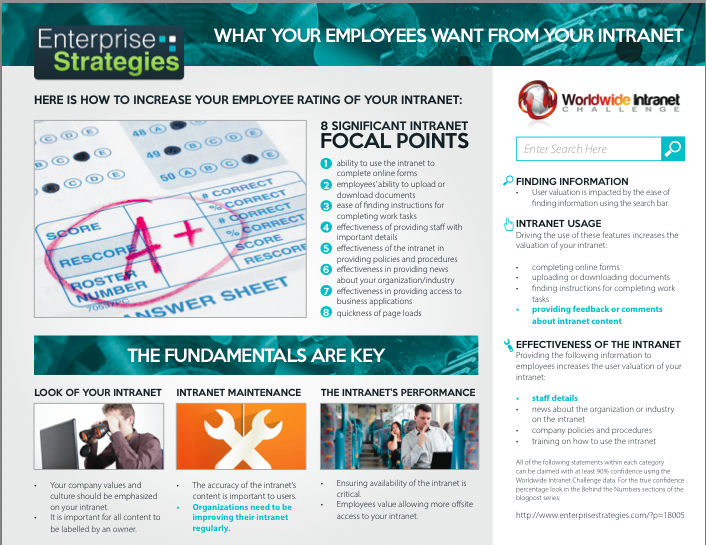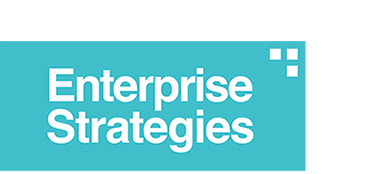
21 Jan Intranets Reimagined: What content are your employees most interested in?
CO-AUTHOR TYLER SAUERTEIG
In partnership with the Worldwide Intranet Challenge, we’ve applied econometric principles to the results of over 200 intranet surveys and statistically pinpointed which types of intranet content most impact a user’s perception of their intranet. This fourth post in the series is focused on the data analysis of “content ” factors — showing which intranet content types have the biggest impact on how employees view their company’s intranet.
Want to anonymously benchmark your company’s intranet? Learn more and register to participate in the Worldwide Intranet Challenge here.
 Free Download: What Your Employees Want From Your Intranet
Free Download: What Your Employees Want From Your Intranet
In this download, you will find the following information:
- Ways to increase your employees’ rating of your company’s intranet
- How to invest your intranet redesign money to get the biggest return
- Key intranet fundamentals to ensure employee engagement
Your Employee Directory is your Intranets “Killer App”
A commonly used definition for intranets is “an internal website that employees use to find the people and information they need to do their job.” We agree, and in fact, our study indicated with 99+% confidence, that an employee’s ability to find “staff details” has one of the greatest positive impacts on their perception of the value of their company’s intranet.
While not a component of our survey data, our observations from working with clients around the world have also confirmed that “social data” (e.g., an employee’s internal social network activity stream, blog posts, group contributions and even badges) are fast becoming an expected part of an employee’s people directory listing. It is no longer acceptable just to be able to view a person’s contact information and where they fit on the org chart.
This makes sense as I think we would all agree that we have come to expect this in our personal lives. When is the last time you made a purchase with out reading an online review first? It is only natural that we would want this same ability at work.Employees want to know what their colleagues know and they also want proof to substantiate the skills and expertise listed.
Additionally, our client interactions suggest that not only is a company’s employee directory their intranet’s killer app, it is also a company’s mobile intranet killer app. In several of the intranet assessments and group discovery sessions we’ve conducted over the last year, when asked what intranet information employees would like to be able to access via mobile, the employee directory is almost always listed first and as most important.
Company News and Policies & Procedures, Still Important but Improved Delivery Expected
Our study also concluded, with a 99+% confidence, that the effectiveness of the intranet in providing news about the your organization as well as quick access to policies & procedures all increase the value that your employees place on your company’s intranet. However, our recent client interactions also confirm the need for intranet teams to provide these items in a way that aligns to how people currently work.
For example, having a text heavy company news article front and center on your homepage is informative, but not as effective (widely read and understood) as presenting this information to employees as a thin screen (screen overlay) on their smart phone or by using a “content container” delivery system such as Citia provides. It is also expected that policies and procedures not just be presented on the intranet, but where appropriate, be actionable on the intranet. In other words, “don’t just tell me what I need to do, give me the facility to then do it without leaving the intranet.”
Intranets can and should be both “modern day” training and knowledge management applications
Our study also concluded, with 95% confidence, that the effectiveness in how your intranet provides training increases an employee’s valuation of the company intranet. Again further discussion with clients confirm that “having a link to a corporate training system” is not enough. Training is expected in multiple, less traditional, forms and formats:
inline videos explaining a new development or concept
embedded social network discussions to allow for the asking and answering of questions
game-ified processes that teach, and reinforce concepts, through doing
Some companies, like Marsh, Inc., a 126 year-old insurance brokerage, have even gone as far as taking the concept of centralized knowledge management and turning it on its head — using the intranet as a platform for decentralized, dynamic (bi-directional discussion), social-network-driven, knowledge capture and management. Compare this to the traditional static page explaining one of your company’s products or services (with a name of who to call for more info) and it does not take much imagination to see the benefits gained.
Not all types of intranet content have a positive impact on a user’s perception of their intranet
So what are some of the types of content that did not fair so well in our analysis? Our study found that the effectiveness in providing calendars and a repository of re-usable documents were actually significant negative influences when it came to an employee’s valuation of their intranet. Does this mean that you should avoid having them on your intranet? Honestly, I do not think it does. As I mentioned in one of our previous posts on this study, “very few studies are perfect.” My interpretation of these two findings is that intranets where calendars and document repositories are key functions are likely older intranets — as these are two features that were emphasized early in the evolution of intranets. In other words, I would view these two findings as indicators that the intranet being referred to, and anonymously benchmarked as part of this study, may have been a bit outdated and in need of a redesign — which could in fact account for the user’s less than terrific perception of its overall value.
Join the discussion
We hope you are finding this study useful and look forward to your comments. We are fortunate to have had some top intranet experts weigh in on our evaluation of intranet “Look Factors” … here’s to another great discussion.
To see the details on how we came to the above conclusions, please grab a (strong) cup of coffee and read the following section.
Behind the Numbers
For this category, we had to correct our equation for the heteroskedasticity within our model and we did so using White Heterosekdasticity-Consistent Standard Errors & Covariance. Heteroskedasticity causes the standard errors to be biased which leads to unreliable hypothesis testing. By using the consistent standard errors, we take a large amount of the bias out of the standard errors and our p-values are much stronger than they are with the regular estimation output. Heteroskedasticity does not bias the coefficients, but the standard errors, so changing to standard errors helps our estimates greatly, and further limits our chance of error in our confidence levels. By using this corrected equation, all econometric problems are accounted for.
| Statement | Coefficient | P-Value |
| Staff Details (eg. Phone, title, etc.) | 0.314 | 0.0001 |
| News about our organization/industry | 0.287 | 0.004 |
| Online or printable (eg. Word) forms | -0.039 | 0.809 |
| Templates | -0.49 | 0.655 |
| A repository of re-usable documents | -0.231 | 0.041 |
| Policies & Procedures | 0.374 | 0.009 |
| Information about our products/services | 0.042 | 0.737 |
| Information about our customers | 0.026 | 0.819 |
| Reports or Dashboards | -0.11 | 0.236 |
| Training (eg. Manuals, online training) | 0.213 | 0.048 |
| Access to business applications | 0.111 | 0.181 |
| Access to external web sites | 0.076 | 0.386 |
| Calendar(s) | -0.159 | 0.095 |
| Information for new starters | -0.146 | 0.177 |
Adjusted- R²: 0.420
The statements within the category of rating the effectiveness of the intranet in providing certain benefits to the employee explain 42% of the variance in the valuation of the intranet by those using it. The statements that are of the highest value to your employees when it comes to what your intranet provides are: staff details, news about our organization/industry, policies and procedures, and training.
- With 99+% confidence we can conclude that the effectiveness of the intranet in providing staff details, news about the organization/industry and policies & procedures all increase the value that your employees place on your company’s intranet.
- With 95% confidence we can conclude that the effectiveness in how your intranet provides training increases the employee valuation of the company intranet.
We also found that the effectiveness in providing calendars and a repository of re-usable documents actually were significant in a negative direction when it came to the employee valuation of the intranet.
- With 95% confidence we can conclude that the effectiveness of the intranet in providing a repository of re-usable documents decreases the value that your employees place on your company’s intranet.
- With 90% confidence we can conclude that the effectiveness of the intranet in providing calendars decreases the value that your employees place on your company’s intranet.
Interpretation of the Coefficient
- When looking only at effectiveness in providing statements, given your answer to the WIC statement “how effective the intranet is in providing staff details“, was ranked one rating higher (better) in the WIC ranking system for that statement, the way that you were ranked in the valuation question “In general, I would rate the intranet as” was, on average, 0.314 ranks higher (better), holding all other variables constant.
You are always curious on what to provide your employees with and what exactly they will use. There is no reason to waste time on providing information that they would not want. Therefore, we hope that this helps you determine what is most important for your employees and what you need to provide them with to make them happiest with your intranet. Join us on our next blog based on the statements in the category of “how the intranet is maintained” to learn more about gaining employee engagement with your intranet.

